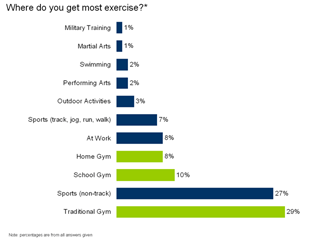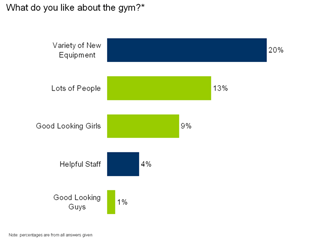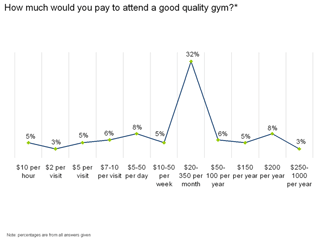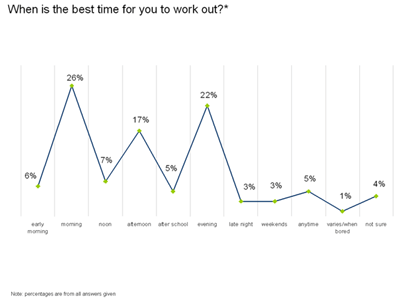retail
industry
 |
I just had a huge, greasy slice of pizza, washed down with a can of soda. I know it's not good for me, but it tasted so good. I keep telling myself that eating like this is alright now, because later, when I've got more time and money, I'll work out and improve my health and appearance. But in reality, the longer I wait, the more comfortable I get with my appearance; the more I adjust my diet to my physical activity, or lack thereof; and ultimately, I rationalize that my life doesn't require that I compete with male models for attention in a whirlwind social calendar. So why waste my money on a gym membership? I know I'm not alone, and frankly, guys like me are a gym's worse target group. But according to my basic demographics, I'm a member of the primary target audience.
More brow-raising is how the industry's financials work: Financial models dictate that aggressive expansion allows a gym to successfully amortize expenses such as marketing across multiple locations. But there's no way of really knowing how much expansion is too much.
Mis-Targeting Potential Customers
In a landmark study conducted by al berrios & co. through 2004, but released this month, we analyzed the viability of an industry and lifestyle that was constantly in the media and still sporadically at the top of the national social agenda. Our research was prompted by dues-based gym membership's generally accepted irrationality (even at only 1.74% of household spending (1)) and our own micro-study on consumer fitness conducted in January of 2004 (2). Our findings do indeed confirm that paying to join a gym long-term is often an irrational decision (believed because we pay for membership we don't always or fully utilize), but we now understand the forces that shape that behavior.
 |
When asked what they like about gyms, the highest percentage, 23%, listed a social benefit (such as good looking girls and guys) vs. 20% who mentioned a functional benefit (such as variety of new equipment). Both this and our previous micro-study clearly revealed that on both age extremes - youngest and oldest - they're less likely to have a gym membership, yet do a lot more working-out than those in-between, who are more likely to join a gym, but work-out less. Our supposed "health craze" appears to have less to do with health and more to do with the basics of human nature.
The Wrong Pricing Model
This helps us also understand the industry's perpetual challenge with retention. After all, once a member has satisfied their social need, there's no time or interest in continuing to work out. But contrary to economics' assertion that irrational behavior is predominantly a price-to-value decision that's outta whack, our research also identified that consumers fully understand their utilization of gyms and what they paying for. When asked how much they'd pay for access to a "good quality gym", 45% of users' answers were based on per-usage, as opposed to monthly or annual fees. In fact, fewer than 7% of consumers mentioned "increasing prices" as a thing they hate about gyms, telling us that consumers are accustomed to and understand the established subscription model of paying for access to the gym. According to our analysis, $1000 per year is about as high as users are willing to go; while gyms generally expect to make about $700 during the lifetime of a user, as per industry average. Regrettably, the economics of this model aren't set up to make money from one-off users, despite this being a clear preference for so many consumers.
 |
A Backwards Financial Picture
The competition isn't any one of the 23,000 fitness clubs across the country. It's outdoor sports, a regular sidewalk, and even work. As a result, in a complete 180-degree direction from the obvious strategy made based on the business' financials or even utilization, it's imperative that facilities owners don't expand. If you recall, users definitely love the variety of gym equipment their membership gives them access to, however, a whopping 65% enjoy their use during three parts of the day - morning, afternoon, and afterwork. Thus, it's no surprise that anytime you go, it's always crowded and frustrating. These compliments and complaints are mistranslated by gyms as needing more equipment or other locations, which in turn, feeds into the logic of the financial model.
These crunch times also mean idle facilities during other day-parts, presenting gyms with at least three familiar alternatives. They can either equip their facilities with the most popular machines (alienating users who appreciate equipment diversity); expand their facilities at a huge loss because idleness is still a problem; or alternatively, remain open for business 24/7 in the hopes of convincing users to stretch their utilization during a full day, rather than specific parts of the day.
Solutions Must Start With Basic Operations
 |
A much needed industry consolidation may permit strategic location of facilities that cater to categories of members re-segmented as "work-out women" (WOW), "work-out men" (WOM), "light-user social-unisex" (LUSU). According to personal trainers we surveyed, it's clear that men and women utilize different equipment and services, and tailoring selection at the unit-level according to a re-segmented group would greatly improve underutilization and retention, as each segment gets what they want from their chosen facility. According to a NY-based trainer, "many more women than men seek the help of personal trainers. One reason is that they are not afraid to ask for help."
And it's cyclical. LUSUs don't generally work out in the summer, preferring immediately after New Years (to fulfill resolutions) and Summer/Fall transition. Trainers agree that both cycles last about a month and begs the question: do people get in shape to go to the gym or do they go to the gym to get in shape? Consequently, it's reasonable to believe that after decades of these cycles and the insights above, the industry has failed to correct the business model at its most fundamental level. It's up to the industry to adopt greater efficiency in how they operate their facilities, one similar to other seasonal businesses (i.e. HR Block), that'll better serve consumers, change speed of depreciation to more favorable scenarios, and lower annual operating costs, while deploying resources strategically when and where needed.
Consider this typical example of the industry's travails: 7% of our population say that they get their workouts by walking, running, jogging, and track. Walking, running, and jogging are exactly the exercises that gyms already have the most equipment for (with at least 30% of manufacturers we identified as serving this market supplying equipment exclusively for legs). So, after decades of operations, why hasn't the industry figured out how to get these people walking, running, and jogging more in gyms?
Methodology
al berrios & co. surveyed
493 consumers using our iResearch
methodology. We then supplemented our survey by interviewing 16 trainers.
And finally, interviewed 3 experts in the financials of the industry.
(2) "Teen
Obesity is Exaggerated; 67% of Teens 13-17 Choose To Work Out"
Top
Related al berrios & co. Reports
- Hitting the Mark In the Fitness Club Industry
Top
Related alberrios.com Sections
- Marketing
Communications reports
Disclaimer:
The recommendations, commentary and opinions published herein are based on
public information sometimes referenced via hyperlinks. Any similarities or
likeness to any ideas or commentary from any other sources not referenced
is purely coincidental. al berrios & co. cannot control any results occurring
from advice obtained from this publication nor any opinion(s) conveyed by
any reader of this publication.
(c) 2005. All Rights Reserved. al berrios & company, inc. Published
by al berrios & co. This Report may not be reproduced or redistributed
in any form without written permission from al berrios & co., subject
to penalty.